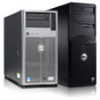Dell PowerEdge XL 5133-4 MXL 10/40GbE Switch IO Module FTOS Command Reference - Page 217
Stacking, Overview, Stacking Aggregators
 |
View all Dell PowerEdge XL 5133-4 manuals
Add to My Manuals
Save this manual to your list of manuals |
Page 217 highlights
17 Stacking Overview An Aggregator auto-configures to operate in standalone mode. To use an Aggregator in a stack, you must manually configure it using the CLI to operate in stacking mode. Stacking is supported only on the 40GbE ports on the base module. Stacking is limited to two Aggregators in the same chassis in a single stack. Up to three stacks of Aggregators are supported in an M1000e chassis. To configure a stack, you must use the CLI. Stacking provides a single point of management for high availability and higher throughput. This chapter contains the following sections: • Stacking Aggregators • Stacking Port Numbers • Configuring a Switch Stack • Verifying a Stack Configuration • Troubleshooting a Switch Stack • Upgrading a Switch Stack • Upgrading a Single Stack Unit Stacking Aggregators A stack of Aggregators operates as a virtual chassis with management units (primary and standby) and member units. The Dell Force10 operating software (FTOS) elects a primary (master) and secondary (standby) management unit. The forwarding database resides on the master switch; the standby unit maintains a synchronized local copy. Each unit in the stack makes forwarding decisions based on their local copy. Figure 17-15 shows an example of how you can stack two Aggregators. The Aggregators are connected to operate as a single stack in a ring topology using only the 40GbE ports on the base modules. Stacking | 203















